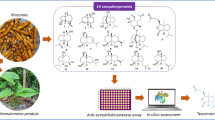Abstract
Inhibition of cholinesterase has been proposed to be a therapeutic target for the treatment of Alzheimer’s diseases. In our preliminary screening study on the acetylcholinesterase (AChE) inhibitory activity, an ethyl acetate soluble fraction of the roots of Harpagophytum procumbens (Pedaliaceae) was found to inhibit AChE activity at the concentration of 100 μg/mL. Ten compounds (1–10) were isolated from the active fraction and evaluated for their inhibitory effect on AChE and butyrylcholinesterase (BChE). Among the isolates, verbascosides (5, 6, and 8) containing a caffeoyl and a 3,4-dihydroxyphenethyl groups in their structures, showed effective AChE inhibitory activity and also possessed BChE inhibitory activity. The findings suggest that verbascoside derivatives may be partially related to the anti-Alzheimer effect of this medicinal plant.

Similar content being viewed by others
References
Boje, K., M. Lechtenberg, and A. Nahrstedt. 2003. New and known iridoid and phenylethanoid glycosides from Harpagophytum procumbens and their in vitro inhibition of human leukocyte elastase. Planta Medica 69: 820–825.
Camps, P., R. El-Achab, J. Morral, D. Muñoz-Torrero, A. Badia, and J.E. Baños. 2000. New tacrine–huperzine A hybrids (huprines): Highly potent tight-binding acetylcholinesterase inhibitors of interest for the treatment of Alzheimer’s disease. Journal of Medicinal Chemistry 43: 4657–4666.
Chrubasik, S., H. Junck, H. Breitschwerdt, C. Conradt, and H. Zappe. 1999. Effectiveness of Harpagophytum extract WS 1531 in the treatment of exacerbation of low back pain; a randomized, placebo-controlled, double-blind study. European Journal of Aanesthesiology 16: 118–129.
Cooper, R., P.H. Solomon, I. Kubo, K. Nakanishi, J.N. Shoolery, and J.L. Occolowitz. 1980. Myricoside, and African armyworm antifeedant separation by droplet countercurrent chromatography. Journal of the American Chemical Society 102: 7955–7956.
Cummings, J.L. 2000. Cholinesterase inhibitors: Expanding applications. Lancet 356: 2024–2025.
Dinda, B., S. Debnath, and R. Banik. 2011. Naturally occurring iridoids and secoiridoids. An updated review, part 4. Chemical & Pharmaceutical Bulletin 59: 803–833.
Ellman, G.L., K.D. Courtney, V.J. Andres, and R.M. Featherstone. 1961. A new and rapid colorimetric determination of acetylcholinesterase activity. Biochemical Pharmacology 7: 88–95.
Ernest, E., and S. Chrubasik. 2000. Phyto-anti-inflammatories. A systematic review of randomized, placebo-controlled, double-blind-trials. Rheumatic Disease Clinics of North America 26: 13–27.
Fox, D.A. 2000. Cytokine blockade as new strategy to treat rheumatoid arthritis: Inhibition of tumor necrosis factor. Archives of Internal Medicine 160: 37–44.
Georgiev, M.I., K. Alipieva, and I.E. Orhan. 2012. Cholinesterases inhibitory and antioxidant activities of Harpagophytum procumbens from in vitro system. Phytotherapy Research 26: 313–316.
Kanchanapoom, T., R. Kasai, and K. Yamasaki. 2002. Phenolic glycosides from Markhamia stipulata. Phytochemistry 59: 557–563.
Leblan, D., P. Chantre, and B. Fournie′. 2000. L’Harpagophyton in the treatment of hip and knee osteoarthritis. Revue Du Rhumatisme 67: 634–640.
Liang, G.J., I.G. Alexander, and G.W. Peter. 1989. Pentacyclic triterpenes from the fruit of Rosa sterilis. Journal of Natural Product 52: 162–166.
Munkombwe, N.M. 2003. Acetylated phenolic glycosides from Harpagophytum procumbens. Phytochemistry 62: 1231–1234.
Parihar, M.S., and T. Hemnani. 2004. Alzheimer’s disease pathogenesis and therapeutic interventions. Journal of Clinical Neuroscience 1: 456–467.
Perry, E.K. 1986. The cholinergic hypothesis—ten years on. British Medical Bulletin 42: 63–69.
Qi, J., J.J. Chen, Z.H. Cheng, J.H. Zhou, B.Y. Yu, and S.X. Qiu. 2006. Iridoid glycosides from Harpagophytum procumbens DC (Devil’s claw). Phytochemistry 67: 1372–1377.
Rao, A.A., G.R. Sridhar, and U.N. Das. 2007. Elevated butyrylcholinesterase and acetylcholinesterase may predict the development of type 2 diabetes mellitus and Alzheimer’s disease. Medical Hypotheses 69: 1272–1276.
Rao, S.R., and G.A. Ravishankar. 2002. Plant cell cultures: Chemical factories of secondary metabolites. Biotechnology Advances 20: 101–153.
Relman, A.S. 1991. Tacrine as a treatment for Alzheimer’s dementia. The New England Journal of Medicine 324: 349–352.
Scarpini, E., P. Scheltens, and H. Feldman. 2003. Treatment of Alzheimer’s disease: Current status and new perspectives. The Lancet Neurology 2: 539–547.
Stewart, K.M., and D. Cole. 2005. The commercial harvest of Devil’s claw (Harpagophytum spp.) in southern Africa: The Devil’s in the details. Journal of Ethnopharmacology 100: 225–236.
Tougu, V. 2001. Acetylcholinesterase: Mechanism of catalysis and inhibition. Current Medicinal Chemistry 1: 155–170.
Van Haelen, M. 1986. La biochimie et l’activite′ d’Harpagophytum procumbens DC. Journal de Pharmacie de Belgique 41: 172–182.
Vassar, R. 2002. Beta-secretase (BACE) as a drug target for Alzheimer’s disease. Advanced Drug Delivery Reviews 54: 1589–1602.
Whitehouse, P.J., D.L. Price, G.R. Struble, A.W. Clarke, J.T. Coyle, and M.R. DeLong. 1982. Alzheimer’s disease and senile dementia: Loss of neurons in the basal forebrain. Science 15: 1237–1239.
Yan, R., M.J. Bienkowski, M.E. Shuck, H. Miao, M.C. Tory, and A.M. Pauley. 1999. Membrane-anchored aspartyl protease with Alzheimer’s disease beta-secretase activity. Nature 402: 533–537.
Yang, H., A.J. Hou, S.X. Mei, H.D. Sun, and C.T. Che. 2002. Constituents of Clerodendrum bungei. Journal of Asian Natural Product Research 4: 165–169.
Acknowledgments
This research was supported by the National Research Foundation of Korea Grant funded by the Korean Government (MEST) (KRF-2012R1A1A2003547) and BK 21 Plus (KRF-22A20130000073). We are grateful to the Korean Basic Science Institute (KBSI) for supplying the NMR spectra.
Author information
Authors and Affiliations
Corresponding author
Additional information
Yoon Ho Bae and To Dao Cuong have contributed equally to this work.
Rights and permissions
About this article
Cite this article
Bae, Y.H., Cuong, T.D., Hung, T.M. et al. Cholinesterase inhibitors from the roots of Harpagophytum procumbens . Arch. Pharm. Res. 37, 1124–1129 (2014). https://doi.org/10.1007/s12272-013-0316-y
Received:
Accepted:
Published:
Issue Date:
DOI: https://doi.org/10.1007/s12272-013-0316-y




